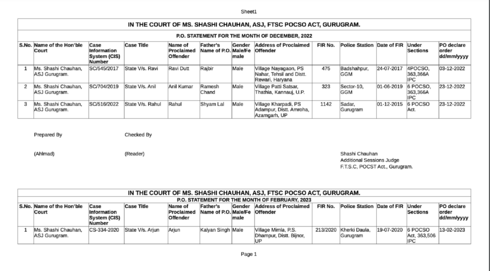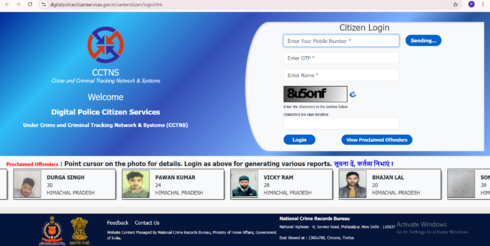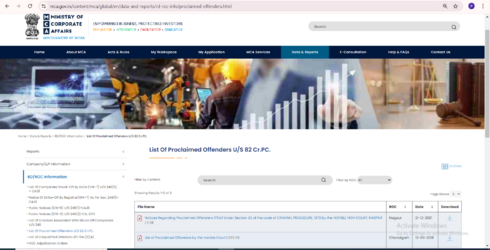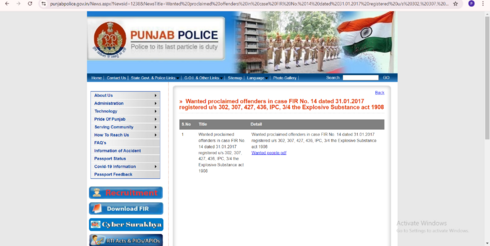Proclaimed offenders
Who is a Proclaimed Offender?
A proclaimed offender generally refers to an individual who has been officially declared by a court as evading arrest or failing to appear in court after a proclamation has been issued against them. It typically implies that the person is wanted by law enforcement for specific criminal charges and is actively avoiding legal proceedings. The word "Proclaim" comes from the Old French word "proclamer", which means "to cry out publicly" or "to announce loudly". This Old French word is derived from the Latin words "pro" (meaning "forth" or "out") and "clamare" (meaning "to cry out" or "to shout").
Official Definition of 'Proclaimed Offender'
Legal Provisions for 'Proclaimed Offender'
Bharatiya Nagarik Suraksha Sanhita (BNSS)
2005 CrPC Amendment
The concept of the "proclaimed offender" in India has undergone significant transformation, beginning with the 2005 amendment to the Code of Criminal Procedure (CrPC) and culminating in its expansion under the Bharatiya Nagarik Suraksha Sanhita (BNSS). The 2005 amendment to CrPC marked a crucial shift by strengthening provisions against absconding accused persons. It introduced measures such as the publication of proclamations for those evading trial and allowed for the attachment of both movable and immovable property through a single court order. The amendment also brought procedural clarity by setting a six-month limit for the release of attached property and enabling interested parties to raise objections. A new section, 174A, was added to the Indian Penal Code (IPC)[1], prescribing stricter penalties up to seven years of imprisonment for those who disobey such proclamations. However, limitations were also placed on police powers by restricting certain actions against individuals merely declared as proclaimed offenders under specific CrPC provisions.
Expansion under the BNSS
The BNSS builds upon these reforms and introduces more stringent and expansive mechanisms. While the CrPC permitted proclamations in relation to only 19 specific offences, the BNSS allows for any absconding accused in cases punishable with ten years or more, life imprisonment, or the death penalty to be declared a proclaimed offender.[2] It also adds provisions for identifying and forfeiting the offender's property located abroad and, crucially, permits in-absentia trials, ensuring that the pursuit of justice is not indefinitely stalled due to the accused’s absence. This legislative progression reflects a growing emphasis on accountability, procedural efficiency, and the rights of victims and society at large to timely justice.
Section 84, BNSS: Declaration of a Proclaimed Offender
Under Section 84 of the BNSS 2023[3] (earlier Section 82 of the CrPC) a court may issue a public proclamation if it believes that a person, against whom a warrant has been issued, is absconding or hiding to avoid arrest. The proclamation must be published by reading it publicly in the person's locality, affixing it to their residence and the courthouse, and optionally publishing it in a local newspaper. If the person fails to appear within 30 days and is accused of an offence punishable with at least 10 years of imprisonment, life imprisonment, or death, the court may, after inquiry, declare them a proclaimed offender.
Sections 35 and 40, BNSS: Arrest Powers for Police and Citizens
Under Section 35(1)(d)[4], police officers are empowered to arrest proclaimed offenders without requiring a warrant or Magistrate's order, while Section 40(1)[5] extends this power to private citizens who must then hand over the arrested person to police within six hours.
Sections 85-89, BNSS: Attachment, Claims, and Property Disposal
Under Section 85[6], the Courts can seize both movable and immovable property of proclaimed offenders; provisions are also provided for immediate attachment if there is risk of asset disposal or removal. Section 86[7] enables international cooperation by allowing courts to seek foreign assistance in identifying and attaching overseas property of proclaimed offenders. The BNSS also establishes a fair claims process under Section 87[8], where third parties can object to property attachment within six months if they have legitimate interests in the seized assets. Section 88[9] governs the release and disposal of attached property, if the proclaimed offender appears in court timely then the property is released; otherwise it transfers to state government, though the person retains a two-year window to reclaim it by proving they didn't deliberately abscond. Appeals against property restoration refusals are permitted under Section 89[10].
Section 356, BNSS: In-Absentia Trials
Section 356[11] allows Court to conduct the trial of a proclaimed offender in their absence if they have absconded to avoid trial and are unlikely to be arrested soon. The trial can begin after 90 days from the date charges are framed, but only after certain procedural safeguards are followed:
· two arrest warrants must be issued 30 days apart
· a notice must be published in a newspaper
· their friend or relative must be informed
· the notice must be posted at their home and the local police station
Witness statements should be recorded using audio-video tools and can be used in trial; if the accused later appears, the court may allow cross-examination. An appeal is allowed only if the person appears before the appellate court within three years of the judgment.
Bharatiya Nyaya Sanhita (BNS)
Under Section 209[12] of the Bharatiya Nyaya Sanhita (BNS), 2023, if someone fails to appear in court after a public proclamation is issued (under Section 84(1), BNSS), they face up to 3 years imprisonment, a fine, both, or community service. However, if they are formally declared a ‘proclaimed offender’ (under Section 84(4), BNSS) the punishment increases significantly to up to 7 years imprisonment with a fine.
Odisha Police Circular Order
The Odisha Police Circular Order 306/2000 classifies absconders into two categories: those against whom proclamations under Section 82, CrPC have been issued (proclaimed offenders) and those without such proclamations. For proclaimed offenders, the Officer-in-Charge must immediately enter their names in the absconders' register once the court issues the proclamation order. The Supreme Court held that non-bailable warrants and proceedings under Sections 82[13] and 83[14] of the CrPC can be initiated during investigation if an accused is evading arrest. In such cases, police must apply to the court with updated case diaries to obtain necessary orders, record the accused’s name in the Absconders Register, and note all steps in the case diary. If the accused remains untraceable, their movable and immovable property should be attached without delay, and with approval from senior officers, a charge sheet may be filed against the absconding accused.
Haryana Police's FAQs
The Haryana Police released a document containing FAQs in relation to proclaimed offenders. The document explains a proclaimed offender (PO) to be individuals designated so by courts under Section 82, CrPC[15] when they abscond after arrest warrants are issued, requiring them to appear within 30 days of a public proclamation. It states that police officers and private citizens can arrest POs without warrants, with non-appearance punishable by up to 3 years imprisonment and declared POs facing up to 7 years imprisonment under Section 174A, IPC.[16] Courts can attach PO property to compel appearance (under Section 83, CrPC[17]), while village officials and residents must report PO sightings to authorities. Police stations maintain registers of POs with their names displayed publicly and harboring a PO is punishable by up to 7 years imprisonment under Section 216, IPC.[18]
Jharkhand Police Manual
The Jharkhand Police Manual states that Section 343(a)[19] requires that when prisoners escape from police or jail custody and their fingerprints were previously taken, the Finger Print slip must be immediately sent to the Finger Print Bureau with a red slip attached to enable identification if arrested elsewhere, and if already forwarded, all relevant bureaux must be informed to place the slip in search records. Section 343(b)[20] mandates that when someone is declared a proclaimed offender, court officers must check conviction registers for existing fingerprint records and immediately notify all concerned bureaux if fingerprints are on record from previous convictions. Section 453[21] establishes that upon receiving reports of proclaimed offenders, escapees, or absconders whose fingerprints are on record, a red slip is attached to their Finger Print slip to ensure immediate police notification if their fingerprints are later received for search purposes.
'Proclaimed Offender' as defined in official government reports
The 41st Report of the Law Commission of India
The 41st Report of the Law Commission of India does not explicitly define 'proclaimed offender' but instead discusses the procedural aspects and implications of proclamations under the Code of Criminal Procedure (CrPC), focusing on the need for clarity and effectiveness in handling absconding accused persons. It emphasizes the need of empowering judges to pronounce judgments even if one or more accused are absconding or are not present, to clarify that the power is used only to prevent undue delays.[22] A consequential amendment was said to be required in Section 383, CrPC to provide that in such cases the Magistrate shall issue a warrant for the arrest of the accused who is absent. The commission's rationale for such recommendations was rooted in the inadequacy of existing provisions in dealing with absconding accused. Similar concerns have been raised regarding the delay in issuing proclamation orders against the absconding accused. It stressed upon the importance of a more effective mechanism to ensure that accused individuals face trial thereby upholding the integrity of the criminal justice system.
The 246th Report on The Bharatiya Nyaya Sanhita, 2023 by the Parliamentary Standing Committee On Home Affairs
The Parliamentary Standing Committee On Home Affairs in the 246th report on The Bharatiya Nyaya Sanhitanotes the addition of a provision in the BNS allowing prosecution of a person abroad who abets an offence in India, giving effect to a 2008 Supreme Court recommendation. Earlier, there was no legal mechanism to prosecute such individuals. While enforcement outside India remains subject to international treaties, the Committee emphasizes the importance of effectively using BNSS provisions on trial in absentia and cross-border investigations to bring such offenders to justice.[23]
The 247th Report on The Bharatiya Nagarik Suraksha Sanhita, 2023 by the Parliamentary Standing Committee On Home Affairs
The Parliamentary Standing Committee On Home Affairs in the 247th report on The Bharatiya Nagarik Suraksha Sanhita notes that the provisions related to the attachment of property of a proclaimed offender and the investigation of offences committed outside India are appreciable steps. It believes these measures will act as effective tools to deter criminal activities, aid in the recovery of ill-gotten gains, and promote international cooperation, making them a valuable part of the legal framework concerning proclaimed offenders.[24]
'Proclaimed Offender' as defined in case laws
In Sanjay Bhandari v. State [25] the Delhi High Court's ruling introduced a radical interpretation, suggesting that the term 'Proclaimed Offender' should be limited to specific offences, leading to significant debate and conflicting opinions among various High Courts. The ruling clarified that only persons accused of the specific serious offences listed in Section 82(4) of the CrPC can be declared 'Proclaimed Offenders.' If someone is accused of any other offence and fails to appear after a proclamation under Section 82(1), they can only be called a 'Proclaimed person,' not a 'Proclaimed Offender,' since no other legal provision allows that designation.
In Deeksha Puri v. State of Haryana [26] Justice M.M.S Bedi's judgement clarified that Section 82(4), CrPC does not limit the declaration of a 'proclaimed offender' only to those accused of offences listed under it. A person declared under either Section 82(1) or 82(4) faces the same legal consequences. The declaration cannot be set aside solely because the offence isn’t among those listed in Section 82(4); however, it can be challenged on procedural grounds, such as improper issuance of a warrant or proclamation. The proclamation becomes ineffective once the person surrenders.
In Rahul Dutta v. State of Haryana [27] it established a precedent that only individuals accused of offences listed under Section 82(4) can be declared as proclaimed offenders, creating a divergence from the Delhi High Court's broader interpretation.
The leading case of Sunil Tyagi v. Govt of NCT of Delhi [28] highlighted two scenarios of abscondence: those who never appear despite being summoned, and those who initially appear and then stop attending. In the first case, courts must ensure the summons is served at a correct and complete address, as mistakes by the prosecution or complainant can lead to failed service and premature proclamations. In the second case, the accused is fully aware of the proceedings and has already furnished bail and surety bonds, making any subsequent absence a significant and incriminating factor. Once charges are framed, the presence of a prima facie case further strengthens the seriousness of such abscondence, as it reflects a deliberate evasion of the judicial process.
The Court laid down comprehensive guidelines clarifying the legal understanding and procedural safeguards around the declaration of a person as a Proclaimed Person or Proclaimed Offender under Section 82, CrPC. The guidelines state that a person can be declared a proclaimed offender only if there is sufficient evidence to show that they are deliberately absconding or concealing themselves to evade arrest. The intention to avoid arrest must be established, and the court must record its subjective satisfaction on this basis using concrete material provided by the police. The label of ‘proclaimed offender’ should not be applied mechanically, but only through a carefully verified and fair process, backed by documentation and procedural compliance.
International Experiences
The concept of a 'proclaimed offender' varies notably across jurisdictions. While some legal systems provide formal statutory definitions, others use the term more broadly to describe individuals evading law enforcement. These differences reflect diverse legal traditions and approaches to criminal procedure. Judicial precedents in various countries have also explored and clarified the scope of this concept.
United Kingdom
In the UK, there is no specific statute that defines 'proclaimed offender,' unlike India which has a well-established statutory framework under Section 82 of the Code of Criminal Procedure (CrPC) 1973. The Police, Crime, Sentencing and Courts Act 2022 introduces comprehensive measures to prevent absconding in the UK, with Section 137 addressing absconding from bail by increasing maximum sentences from 6 months to 2 years and allowing electronic monitoring.
While the UK focuses on general absconding provisions and bail violations, India provides explicit statutory definitions for proclaimed offenders with detailed procedural requirements. Section 138 of the UK Act deals with failure to appear at court, similarly increasing penalties and empowering arrest warrants, whereas India's approach centers on proclamation procedures for those who fail to appear before court.
BNSS limits proclaimed offenders to serious crimes, contrasting with the UK's expansion of penalties across all absconding cases. The UK's Bail Act 1976 has been amended to include new provisions related to absconding, emphasizing enhanced deterrence through stricter sentences. India's system maintains comprehensive procedural safeguards including warrant prerequisites and court satisfaction regarding the accused's absconding status. Both jurisdictions recognize the serious nature of non-appearance, but India's approach remains more procedurally detailed while the UK emphasizes penalty enhancement.
Both systems address absconding through legally appropriate mechanisms, with the UK prioritizing deterrence through enhanced penalties and India focusing on comprehensive procedural compliance. The contrasting approaches highlight different legal traditions in addressing the same fundamental challenge of ensuring court appearance.
South Africa
South Africa's Criminal Procedure Act employs a preventive approach through strict bail conditions, while India's framework primarily relies on post-absconding remedies. Under South Africa's Section 60(11) of the CPA, accused persons charged with Schedule 5 offences must adduce evidence satisfying the court that the interests of justice permit their release. This creates a presumption against bail for serious offences. Section 60(4)(b) specifically provides that the interests of justice do not permit release where there is likelihood that the accused would attempt to evade trial if released on bail.
The Indian system permits initial bail in most circumstances but imposes severe consequences post-absconding, including property attachment and denial of future anticipatory bail. South Africa's framework demonstrates greater judicial intervention at the initial stage, with courts required to assess flight risk before granting bail. The Luphondo v S decision exemplifies this approach, where courts must balance the seriousness of charges against likelihood of absconding. India's system shows more deference to initial liberty but creates harsher post-absconding penalties. [29]
South Africa prevents absconding through stringent pre-trial controls based on offence categories, while India addresses it through post-absconding consequences.
United States
Under U.S. federal law, specifically § 922(g)(2), the term "fugitive from justice" is defined as any person who has fled from any State to avoid prosecution for a crime or to avoid giving testimony in any criminal proceeding. However, the mere act of fleeing is insufficient to establish fugitive status.
As established in United States v. Soza, 874 F.3d 884 (5th Cir. 2017), there is a required mens rea component that must be proven. The Ninth and Eleventh Circuits have consistently held that to establish defendant status as a fugitive from justice, the government bears the burden of demonstrating that the defendant fled with the specific intent to avoid prosecution. The legal framework requires proof that "any person who, knowing that charges are pending, purposely (1) leaves the jurisdiction of prosecution and (2) refuses to answer those charges by way of appearance before the prosecuting tribunal, is a fugitive from justice."
Unlike the U.S. system's emphasis on proving subjective intent to evade prosecution, India's framework prioritizes court-directed proclamation processes over mental element requirements.
Canada
In Canada, Section 475 of the Criminal Code governs the procedure when an accused absconds during trial. Under this provision, if the accused flees after the trial has commenced, they are deemed to have waived their right to be present. The court may then proceed with the trial in their absence, deliver a verdict, and, if applicable, impose a sentence. A warrant may be issued for the arrest of the accused, and the court can adjourn proceedings while awaiting their return. However, if the court determines that delaying the trial is no longer in the interests of justice, it may continue the proceedings at any time.
Appearance of 'Proclaimed Offender' in Databases
e-Courts (District Courts)
District courts across India publish data on proclaimed offenders in diverse formats, reflecting varying administrative practices and levels of digitization. These compilations often include key identifiers such as case numbers, FIR details, police station jurisdiction, and relevant legal provisions, though the structure and accessibility of such information may differ significantly across jurisdictions.
- FTSC POCSO Act, Gurugram
The Fast Track Special Court in Gurugram under the POCSO Act provides details such as the CIS number, case title, name of the proclaimed offender, father's name, gender, FIR number, police station, date of the proclamation order, and the relevant legal provisions invoked.

- District and Sessions Court, Ambala
These records illustrates how district-level courts in India disclose information on proclaimed offenders. It includes essential case-related data such as names, FIR numbers, associated police stations, and relevant legal provisions. The practice reflects an institutional commitment to procedural transparency and facilitates public access to judicial information within the criminal justice framework.

Central Government Databases
Ministry of Home Affairs
The Crime and Criminal Tracking Network and Systems (CCTNS), launched in 2009 under the Ministry of Home Affairs, aims to enhance transparency and efficiency in policing through digital integration. Accessible via e-police services, CCTNS allows citizens to log in using their phone number to retrieve details about proclaimed offenders for any specified time frame. Several States have their own CCTNS portal, where information on FIR status, missing persons, absconders, and proclaimed offenders is available. In states where online access is enabled, users can search for proclaimed offenders by entering details such as the person's name, district, proclamation date range, and police station.

Ministry of Corporate Affairs
The Ministry of Corporate Affairs (MCA) publishes a consolidated list of individuals declared as proclaimed offenders under Section 82, CrPC. This list, available on the MCA website, includes names notified by various Registrars of Companies (ROCs) across India. It serves as an official public record of persons who have absconded from legal proceedings in corporate-related cases, aiding in transparency, compliance checks, and enforcement actions.

State Police Databases
State Police departments use varied systems, either CCTNS or independent databases, to compile lists of Proclaimed Offenders, recording details such as name, FIR number, offence, address, and more. Several States across India maintain and publish proclaimed offenders’ lists through their respective police department websites or designated state-level portals. These lists are typically made available to the public and are updated periodically, reflecting efforts by individual states to enhance transparency and streamline the tracking of absconding accused persons. The platforms provide access to details of proclaimed offenders, enabling users to search using relevant information such as FIR number, name, district, and police station. By entering these details, users can retrieve case-specific data, facilitating efficient and targeted access to information on absconding individuals through digital policing systems. The following States are using their department websites to publish the lists:




Research that engages with 'Proclaimed Offender'
Understanding the need for Judicial Impact Assessment (DAKSH)
An article by DAKSH, authored by Sandhya PR states the importance of the Judicial Impact Assessment (JIA). In the context of proclaimed offenders, a JIA can assess how criminal provisions, such as those under Section 138 of the Negotiable Instruments Act, contribute to delays due to procedural requirements like declaring an absconding accused as a proclaimed offender. Converting such offences from criminal to civil processes may reduce pendency on record but could weaken enforcement mechanisms. JIAs help ensure that legal changes improve court functioning, reduce delays, and strengthen the overall effectiveness of the justice system.
Who is a 'Proclaimed Offender'? Putting the CrPC's Interpretative Imbroglio to Rest (NALSAR Student Law Review)
This academic paper by Jaideep Singh Lalli examines a critical interpretative conflict in Indian criminal law regarding the definition of 'proclaimed offender' under the Criminal Procedure Code. The dispute arose from 2005 amendments that created a formal declaration process under Section 82(4) for specific serious offenses, leading to conflicting High Court judgments about whether this changed the broader meaning of "proclaimed offender" in other CrPC provisions. While some courts restricted the term only to those formally declared under Section 82(4), others maintained the historical interpretation where anyone subject to a proclamation could be considered a "proclaimed offender." The paper argues for a harmonious construction that preserves the traditional meaning for procedural purposes while limiting the enhanced penalties under Section 174A of the Indian Penal Code to those formally declared under Section 82(4), concluding that the Delhi High Court's restrictive interpretation undermines the CrPC's enforcement mechanisms and awaits resolution by the Supreme Court.
Challenges
Under the following heads, the challenges faced have been enlisted: [30]
- Ambiguity in Definitions: The terms 'proclaimed offender' and 'proclaimed person' have been subject to varying interpretations, particularly after the 2005 amendment to Section 82, CrPC. This ambiguity can lead to confusion in legal proceedings, as courts may apply different standards for what constitutes a 'proclaimed offender,' impacting the rights of the accused and the efficacy of law enforcement.
- Inconsistent Judicial Interpretations: Various High Courts in India, such as the Delhi High Court and the Punjab & Haryana High Court, have issued conflicting rulings regarding the criteria and implications of declaring someone a 'proclaimed offender.' For instance, the Delhi High Court's restrictive interpretation limits the application of Sections 40, 41, 43, and 73 of the CrPC, while other courts may adopt a broader view, leading to a lack of uniformity in legal practice.
- Procedural Delays and Procedural Non-Compliances: The process of issuing proclamations under Section 82 can be cumbersome, often involving multiple hearings and bureaucratic steps. These delays can allow offenders to evade law enforcement for extended periods, undermining the effectiveness of the legal system and prolonging the suffering of victims. In prosecution of cases of Section 174A, IPC the procedural compliances required by Section 195, CrPC at the stage of cognizance needs to be adhered to.
- Need for Accurate Personal Identification in Tracing Proclaimed Offenders: Tracing proclaimed offenders requires accurate and comprehensive personal identification details such as good-quality photographs, fingerprint records, full name, parentage, date of birth, native place, and last known address. Additionally, copies of photo identity documents such as passport, PAN card, Voter ID (EPIC), and proof of address are essential. Physical identifiers like height, distinctive facial features, and identification marks, along with communication details such as email IDs, mobile and landline numbers, also play a critical role. In today’s digital age, information on social media accounts like Facebook and WhatsApp can further aid in tracking. However, access to such data is often limited due to poor documentation, weak inter-agency coordination, and privacy-related concerns, posing a significant challenge to law enforcement efforts.
- Inadequate Efforts in Tracing Proclaimed Offenders in International Jurisdictions: When a Proclaimed Offender is suspected to have crossed into an international jurisdiction, investigative agencies do not always initiate systematic efforts to trace them abroad. The available mechanisms for international cooperation are often underutilized, and the assistance of INTERPOL is not consistently sought. In particular, suitable INTERPOL notices to alert foreign law enforcement agencies and seek their support in locating and apprehending the offender are not always issued, resulting in missed opportunities for effective cross-border enforcement.
- Limited Engagement of Public Assistance in Tracing Proclaimed Offenders: Despite the provisions under Section 82(2) of the CrPC, which mandate the issuance of a written proclamation and its public display, investigative agencies often fall short in ensuring wide publicity. The absence of consistent efforts to inform the public through newspapers, local announcements, or digital platforms reduces the chances of locating absconding individuals, thereby weakening the efficacy of the proclamation process.
- Inaccessibility and Incompleteness of Public Databases like ZIPNet: While the Zonal Integrated Police Network (ZIPNet) was launched with the objective of creating a centralized platform for sharing crime and criminal data across multiple states, its implementation with respect to proclaimed offenders remains inadequate. Although the ZIPNet portal lists 'Proclaimed Offenders' as one of its searchable categories, in practice, this section remains inaccessible or empty, with no actual data available to the public. Moreover, despite the portal's claim of integration with several states such as Delhi, Haryana, Uttar Pradesh, Rajasthan, Punjab, Chandigarh, Uttarakhand, and Himachal Pradesh, many of these states either do not maintain updated data or their local ZIPNet portals are non-functional or missing altogether. This undermines the very purpose of creating an integrated and transparent information system, hindering efforts by law enforcement, researchers, and the public to track and monitor absconding accused persons across jurisdictions.
- Inconsistent Accessibility and Technical Barriers Across States: Accessing information on proclaimed offenders is hindered by inconsistent and inaccessible state police and CCTNS platforms. The lack of uniform digital systems and public access undermines transparency. The following states reflect these challenges:
- Chhattisgarh uses the CCTNS platform, but it requires login credentials. The public-facing citizen portal does not display any list of proclaimed offenders.
- Rajasthan Police’s website is currently non-functional, preventing access to any data related to proclaimed offenders.
- West Bengal, Nagaland, and Uttar Pradesh have operational CCTNS portals; however, none provide publicly accessible proclaimed offender lists.
- Manipur and Mizoram have CCTNS websites that do not load or remain inaccessible, effectively cutting off digital access.
Way Ahead
The way forward has been outlined under the following headings: [31]
- Standardized Judicial Guidelines: The Supreme Court of India could issue comprehensive guidelines that outline the procedural requirements and substantive criteria for courts when designating individuals as 'proclaimed offenders.' This would help harmonize interpretations and ensure that all courts apply the law uniformly, reducing the risk of arbitrary decisions.
- Technological Aid: Implementing technology-driven solutions, such as digital platforms for filing and processing proclamations, could significantly expedite the legal process. Additionally, training law enforcement and judicial officers on efficient practices for handling cases involving proclaimed offenders can enhance the overall effectiveness of the system, ensuring timely justice and reducing the chances of offenders evading arrest. Partnering with technology firms can help in developing advanced tracking systems and databases can improve the efficiency of locating and apprehending proclaimed offenders. Utilizing data analytics and artificial intelligence can enhance predictive policing efforts and resource allocation.
- Public Awareness Campaigns: Initiatives aimed at educating the public and law enforcement about the legal framework surrounding proclaimed offenders can foster better understanding and compliance. Workshops, seminars, and informational materials can help clarify the rights of individuals and the responsibilities of authorities.
- Resource Allocation: Governments should allocate adequate resources to law enforcement agencies to enhance their capabilities in tracking and apprehending proclaimed offenders. This includes investing in technology, training, and personnel to improve operational efficiency.
- Oversight Mechanisms: Establishing independent oversight bodies to review cases of declared proclaimed offenders can help prevent misuse of power and ensure accountability. These bodies can investigate complaints and provide recommendations for reform where necessary.
Related Terms
In legal contexts, two distinct categories of individuals are recognized in relation to absconding: proclaimed persons and proclaimed offenders.
An absconder, on the other hand, may be formally declared a proclaimed offender under Section 82 of the CrPC. A proclaimed person refers to someone against whom a proclamation has been issued under Section 82(1) of the CrPC due to their deliberate evasion of arrest, but who may not necessarily be accused of offences listed in Section 82(4). These individuals are generally seen as obstructing the course of justice by not complying with the summons or warrants issued against them. Precedents have been laid down stating that a person who is evading the execution of warrants of arrest issued under the other provisions of the IPC and the laws, can be declared to be a proclaimed person in terms of Section 82(1), CrPC.[32]
References
- ↑ https://indiankanoon.org/doc/119436650/
- ↑ https://p39ablog.com/2023/11/criminal-law-bills-2023-decoded-11-proclaimed-offenders-and-trials-in-absentia/
- ↑ https://indiankanoon.org/doc/148501062/
- ↑ https://indiankanoon.org/doc/75059398/
- ↑ https://indiankanoon.org/doc/27653025/
- ↑ https://indiankanoon.org/doc/65447282/
- ↑ https://indiankanoon.org/doc/130440597/
- ↑ https://indiankanoon.org/doc/137764077/
- ↑ https://indiankanoon.org/doc/134926695/
- ↑ https://indiankanoon.org/doc/38706189/
- ↑ https://indiankanoon.org/doc/105262049/
- ↑ https://indiankanoon.org/doc/145699312/
- ↑ https://indiankanoon.org/doc/1598801/
- ↑ https://indiankanoon.org/doc/886456/
- ↑ https://indiankanoon.org/doc/1598801/
- ↑ https://indiankanoon.org/doc/119436650/
- ↑ https://indiankanoon.org/doc/886456/
- ↑ https://indiankanoon.org/doc/1865807/
- ↑ Jharkhand Police Department, Jharkhand Police Manual, Page 183
- ↑ Jharkhand Police Department, Jharkhand Police Manual, Page 183
- ↑ Jharkhand Police Department, Jharkhand Police Manual, Page 234
- ↑ Part B of Law commission 41st report https://www.manupatrafast.in/pers/Personalized.aspx note at pg. 67 Pt 26.6
- ↑ Ministry of Home Affairs, Government of India, 246th Report on The Bharatiya Nyaya Sanhita, Page 5
- ↑ Ministry of Home Affairs, Government of India, 247th Report on The Bharatiya Nagarik Suraksha Sanhita, 2023, Page 13
- ↑ 2018 SCC OnLine Del 10203
- ↑ CRM M-359 of 2012
- ↑ 2011 SCC OnLine P&H 16868
- ↑ (2021) 4 HCC (Del) 723
- ↑ (SS026/2014) [2022] ZAGPJHC 631
- ↑ Garg, M., & Kundu, A. (2023). Analysing Declaration of Proclamation under the Code of Criminal Procedure.# Issue 1 Indian JL & Legal Rsch., 5, 1. https://heinonline.org/HOL/Page?handle=hein.journals/injlolw10&div=62&g_sent=1&casa_token=&collection=journals
- ↑ https://www.livelaw.in/news-updates/delhi-high-court-issues-guidelines-for-declaring-persons-as-proclaimed-offenders-their-early-apprehension-176663
- ↑ Rahul Dutta vs State Of Haryana CRM-M-34328-2011
